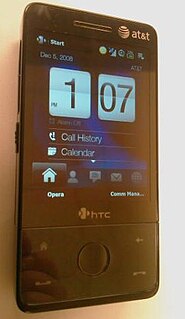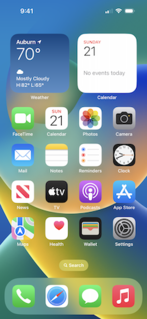The Windows shell is the graphical user interface for the Microsoft Windows operating system. Its readily identifiable elements consist of the desktop, the taskbar, the Start menu, the task switcher and the AutoPlay feature. On some versions of Windows, it also includes Flip 3D and the charms. In Windows 10, the Windows Shell Experience Host interface drives visuals like the Start Menu, Action Center, Taskbar, and Task View/Timeline. However, the Windows shell also implements a shell namespace that enables computer programs running on Windows to access the computer's resources via the hierarchy of shell objects. "Desktop" is the top object of the hierarchy; below it there are a number of files and folders stored on the disk, as well as a number of special folders whose contents are either virtual or dynamically created. Recycle Bin, Libraries, Control Panel, This PC and Network are examples of such shell objects.

The HTC Touch Diamond, also known as the HTC P3700 or its codename the HTC Diamond, is a Windows Mobile 6.1-powered Pocket PC designed and manufactured by HTC. It is the first device to feature TouchFLO 3D - a new version of the TouchFLO interface, unique to the Touch family. The HTC Touch Diamond was first available in Hong Kong in late May 2008. It was available across all major European carriers in June 2008, and later in the year in other parts of the world. The American Touch Diamond was launched on September 14, 2008 on the Sprint network, and April 10, 2009 on the Verizon Wireless network. The European release date was slightly delayed by a last-minute ROM update. The carrier bound names for this phone include T-Mobile MDA Compact IV, O2 XDA Diamond and O2 XDA Ignito. It is the official successor of the HTC Touch.

The HTC Touch Pro is a smart phone from the Touch series of Internet-enabled Windows Mobile Pocket PC smartphones designed and marketed by HTC Corporation of Taiwan. It is an enhanced version of the HTC Touch Diamond with the addition of a left-side slide-out QWERTY keyboard, a microSD card slot, and a camera flash. The Touch Pro smartphone's functions include those of a camera phone and a portable media player in addition to text messaging and multimedia messaging. It also offers Internet services including e-mail, instant messaging, web browsing, and local Wi-Fi connectivity. Depending on its market, it is a quad-band GSM or quad-band UMTS phone with GPRS, EDGE, UMTS, HSDPA, and HSUPA or a tri-band CDMA phone with 1xEV-DO Rev A. All versions feature TouchFLO 3D — a new enhanced version of the TouchFLO interface, unique only to the latest Touch series. In March 2009, HTC announced a new version, the Touch Pro2 which has a larger screen (3.6") and a redesigned slide out QWERTY keyboard with spaces between the keys.
The LG VX9700 is a CDMA touch screen cell phone made by LG. The phone features touch screen navigation, a 3.2-megapixel camera with face recognition and many photo enhancing tools, a camcorder, customizable shortcut menus, handwriting recognition, and a multitask music player. The LG Dare is the third phone to have Rev. A technology - after the Sprint Mogul and Touch.
The HTC Touch family was a family of Pocket PCs designed and manufactured by HTC Corporation. Its slogan was Discover Touchnology.

The HTC Touch HD, also known as the HTC T828X or its codename the HTC Blackstone, is a Windows Mobile 6.1 Pocket PC designed and manufactured by HTC launched in 2008.
Samsung SCH-U940 is a Verizon Wireless touch-screen phone made by Samsung. The Glyde was based on the popular European Croix, but was later adapted for the United States. It was released in late May 2008 in Verizon stores. As of August 2009, the phone is no longer listed for sale on Verizon's website. The phone features touch screen navigation, a 2.0-megapixel camera/camcorder with flash, customizable shortcut menus, and a full HTML browser. The phone has been replaced by a newer version, the Samsung Rogue.

The HTC Touch Pro2 is a slate smartphone, part of the Touch series of Internet-enabled, Windows Mobile, Pocket PC smartphones designed and marketed by HTC Corporation of Taiwan. It is an enhanced version of the HTC Touch Pro with a left-side slide-out QWERTY keyboard, with tilting screen. The Touch Pro2 smartphone's functions include those of a camera phone and a portable media player in addition to text messaging and multimedia messaging. It also offers Internet services including e-mail, instant messaging, web browsing, and local Wi-Fi connectivity. Visual voicemail is not a standard feature for the Touch Pro2, unlike its predecessor the Touch Pro. The Verizon Wireless version does include a visual voicemail application, however. All versions feature TouchFLO 3D — a new enhanced version of the TouchFLO interface, unique only to the latest Touch series. The latest update renamed TouchFLO 3D to SenseUI, to match HTC's Android offering. The Touch Pro2 — along with its sister model, the Touch Diamond2 — were unveiled on February 16, 2009 in Barcelona, Spain at the Mobile World Congress 2009. Specific enhancements over the original Touch Pro include:

The HTC Touch Diamond2, a mobile phone designed by the HTC Corporation, is the successor to the popular HTC Touch Diamond. It is also known by its codename, the HTC Topaz. It is released with Microsoft Windows Mobile 6.1, but can be upgraded to Windows Mobile 6.5. It is the first device to feature a revamped version of HTC's TouchFLO 3D GUI, an interface first seen on its predecessor. The Touch Diamond2 has been announced to be released in Q2 2009 and was first announced at the Mobile World Congress 2009 in Barcelona.

HTC Sense is a software suite developed by HTC, used primarily on the company's Android-based devices. Serving as a successor to HTC's TouchFLO 3D software for Windows Mobile, Sense modifies many aspects of the Android user experience, incorporating additional features, additional widgets, re-designed applications, and additional HTC-developed applications. The first device with Sense, the HTC Hero, was released in 2009. The HD2 running Windows Mobile 6.5, released later the same year, included Sense. Following the release of the Hero, all future Android devices by HTC were shipped with Sense, except for the Nexus One, the Desire Z, the HTC First, the Google Pixel and Pixel 2, and the Nexus 9 which used a stock version of Android. Also some HTC smartphones that are using MediaTek processors come without HTC Sense.
The Samsung SCH U960 is a CDMA touchscreen side-slider cell phone made by Samsung. The phone features a QWERTY keyboard, Bluetooth, MP3 Player, GPS, and a 3MP camera with Geo Tagging. It uses Verizon's EVDO Rev A data network. The Rogue runs Samsung’s TouchWiz UI with a widget bar on the side. Social networking widgets including those from Facebook, MySpace, YouTube, Twitter, and Photobucket are widely represented on the widget bar. The Rogue also has widgets for most commonly used applications like calendar, favorite contacts and tools such as Bluetooth and settings. Like other TouchWiz phones, the user can drag widgets to the phone’s today screen and select which widgets populate the widget bar. The phone does not support downloading additional widgets.

The HTC Evo 4G is a smartphone developed by HTC Corporation and marketed as Sprint's flagship Android smartphone, running on its WiMAX network. The smartphone was launched on June 4, 2010. It was the first 4G enabled smartphone released in the United States.
The HTC Evo Shift 4G is a smartphone developed by HTC Corporation and marketed as the concurrent/sequel to Sprint's flagship Android smartphone, running on its 4G WiMAX network. The smartphone launched on January 9, 2011.
The HTC Flyer is a tablet computer by HTC Corporation. It was announced at the Mobile World Congress (MWC) 2011 and released in May 2011. Unlike other tablets announced at MWC, the Flyer has a single-core 1.5 GHz CPU and ran 2.3.3 (Gingerbread). In February 2011 it was reported that HTC had claimed via Facebook that "Flyer will be getting a Honeycomb upgrade in Q2", however an HTC representative subsequently stated "I can confirm that we are working to bring a Honeycomb update to Flyer in short order – however, I don't have any specific information on what the timing may be." The version running Android 3.2.1 (Honeycomb) was released later in 2011. The HTC Flyer can be updated up to Android Jelly Bean 4.1.1 through the use of custom ROMs.
A lock screen is a computer user interface element used by various operating systems. They regulate immediate access to a device by requiring the user to perform a certain action in order to receive access, such as entering a password, using a certain button combination, or performing a certain gesture using a device's touchscreen. There are various authentication methods to get past the lock screen, with the most popular and common ones being personal identification numbers (PINs), the Android pattern lock, and biometrics.

iOS 10 is the tenth major release of the iOS mobile operating system developed by Apple Inc., being the successor to iOS 9. It was announced at the company's Worldwide Developers Conference on June 13, 2016, and was released on September 13, that year. It was succeeded by iOS 11 on September 19, 2017.

Samsung Experience was a software overlay for the Android "launcher" by Samsung for its Galaxy devices running Android 7.x “Nougat” and Android 8.x “Oreo”. It was introduced in late 2016 on a beta build based on Android 7.0 “Nougat” for the Galaxy S7, succeeding TouchWiz. It has been succeeded by One UI based on Android 9 “Pie” and later versions.

iOS 15 is the fifteenth major release of the iOS mobile operating system developed by Apple for its iPhone and iPod Touch lines of products. It was announced at the company's Worldwide Developers Conference on June 7, 2021, as the successor to iOS 14, and released to the public on September 20, 2021.

iOS 16 is the 16th and current major release of the iOS mobile operating system developed by Apple for its iPhone line of products. It was announced at the company's Worldwide Developers Conference (WWDC) on June 6, 2022, as the successor to iOS 15.











